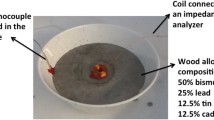Abstract
The paper shows the possibilities of using a fluorine-containing liquid—the so-called dry water for the MRI of inanimate objects using the signal void imaging method. Examples of visualization of objects that cannot be immersed in ordinary water and other liquid media that can dissolve or spoil the object under study are presented. The possibilities of visualization of a radio engineering product immersed in dry water during its operation are shown. Namely, the coil, which itself is involved in the scanning process, is used to receive and/or transmit RF power. It is shown that the images of the medium surrounding the coil obtained in this case make it possible to construct sensitivity maps and B1 maps of this coil. The issues of optimization of scanning parameters based on information about the 19F NMR spectrum and measurements of relaxation times for a given liquid are discussed.



Similar content being viewed by others
Availability of Data and Materials
The datasets generated during and/or analyzed during the current study are available from the corresponding author on reasonable request.
References
E.M. Haacke, Magnetic resonance imaging: physical principles and sequence design (Wiley, New York, 1999), p.944
W. Kuhn, Angew. Chem. Int. Ed Engl. 29, 1–112 (1990)
H. Ebrahimnejad, H. Ebrahimnejad, A. Salajegheh, H. Barghi, J. Biomed. Phys. Eng. 8(1), 127–132 (2018)
N.V. Anisimov, Yu.A. Pirogov. Patent RU 2 308 025 C1 https://yandex.ru/patents/doc/RU2308025C1_20071010. Accessed 17 July 2023 (in Russian)
N.V. Anisimov, S.S. Batova, Yu.A. Pirogov, Magnetic resonance tomography: contrast control and interdisciplinary applications, (MAKS Press, Moscow, 2013), p. 244. (in Russian)
V.Z. Miloushev, K.R. Keshari, A. Holodny, Top Magn Reson Imaging. 25(1), 31–37 (2016)
O.S. Pavlova, N.V. Anisimov, L.L. Gervits, M.V. Gulyaev, V.N. Semenova, Yu.A. Pirogov, V.Y. Panchenko, Magn. Reson. Med. 84(4), 2111–2123 (2020)
N.V. Anisimov, O.S. Pavlova, A.A. Tarasova, I.A. Usanov, M.V. Gulyaev, Yu.A. Pirogov, Appl. Magn. Reson. 53, 1575–1585 (2022)
Perfluoro(2-methyl-3-pentanone) https://en.wikipedia.org/wiki/Perfluoro(2-methyl-3-pentanone). Accessed 17 July 2023
Fire suppression—3M™ Novec™ 1230 Fire Protection Fluid https://www.3m.co.uk/3M/en_GB/novec-uk/applications/fire-suppression/. Accessed 17 July 2023
J.T. Gerig, Fluorine NMR, 1–35 https://www.biophysics.org/Portals/0/BPSAssets/Articles/gerig.pdf. Accessed 17 July 2023 (2001)
C.A. Schneider, W.S. Rasband, K.W. Eliceiri, Nat. Methods 9(7), 671–675 (2012)
G. van Kaick, S. Delorme, Eur. Radiol. Suppl. 15(Suppl 4), d74–d81 (2005)
M. Meissner, M. Reisert, T. Hugger, J. Hennig, D. von Elverfeldt, J. Leupold, Magn. Reson. Med. 73, 2225–2233 (2015)
D.I. Hoult, P.C. Lauterbur, J. Magn. Reson. 34, 425–433 (1979)
A.J. Ilott, A. Jerschow https://doi.org/10.48550/arXiv.1806.01390. Accessed 17 July 2023 (2018)
Acknowledgements
This research was supported by the Russian Foundation for Basic Research grants No. 19-29-10015 and Russian Scientific Foundation grant No. 21-75-10038, the Interdisciplinary Scientific and Educational Schools of Moscow University “Molecular Technologies of the Living Systems and Synthetic Biology” and “Photonic and quantum technologies. Digital medicine”. Access to electronic scientific resources was provided by Nesmeyanov Institute of Organoelement Compounds of the Russian Academy of Sciences with the support of the Ministry of Science and Higher Education of the Russian Federation.
Funding
This research was supported by the Russian Foundation for Basic Research grants No. 19-29-10015 and Russian Scientific Foundation grant No. 21–75-10038.
Ethics declarations
Conflict of interest
The authors declare no competing interests.
Ethical approval
Not applicable.
Additional information
Publisher's Note
Springer Nature remains neutral with regard to jurisdictional claims in published maps and institutional affiliations.
Supplementary Information
Below is the link to the electronic supplementary material.
Rights and permissions
Springer Nature or its licensor (e.g. a society or other partner) holds exclusive rights to this article under a publishing agreement with the author(s) or other rightsholder(s); author self-archiving of the accepted manuscript version of this article is solely governed by the terms of such publishing agreement and applicable law.
About this article
Cite this article
Anisimov, N.V., Gervits, L.L., Tarasova, A.A. et al. MRI of Inanimate Objects Using Fluorine-Containing Liquid. Appl Magn Reson 54, 895–904 (2023). https://doi.org/10.1007/s00723-023-01580-5
Received:
Revised:
Accepted:
Published:
Issue Date:
DOI: https://doi.org/10.1007/s00723-023-01580-5




